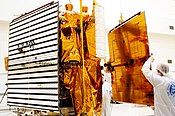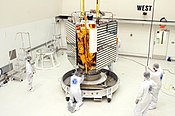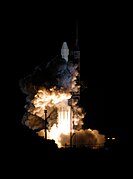MESSENGER: Difference between revisions
m Robot - Speedily moving category Discovery program to Category:Discovery Program per CFDS. |
|||
| Line 94: | Line 94: | ||
===Previous missions=== |
===Previous missions=== |
||
In 1973, [[Mariner 10]] was launched to make multiple flyby encounters of Venus and Mercury. Mariner 10 provided the first detailed data of Mercury, mapping 40-45% of the surface.<ref name="USATMessenger">{{cite news|url=http://www.usatoday.com/tech/news/2004-08-16-mercury-may-shrink_x.htm |title=MESSENGER to test theory of shrinking Mercury|publisher=USA Today| first=Tariq | last= Malik|date=August 16, 2004 |accessdate=May 23, 2012}}</ref> The final flyby of Mercury by Mariner 10 occurred on March 16, 1975. No subsequent close-range observations of the planet would take place for more than 30 years. |
In 1973, [[Mariner 10]] was launched to make multiple flyby encounters of Venus and Mercury. Mariner 10 provided the first detailed data of Mercury, mapping 40-45% of the surface.<ref name="USATMessenger">{{cite news|url=http://www.usatoday.com/tech/news/2004-08-16-mercury-may-shrink_x.htm |title=MESSENGER to test theory of shrinking Mercury|publisher=USA Today| first=Tariq | last= Malik|date=August 16, 2004 |accessdate=May 23, 2012}}</ref> The final flyby of Mercury by Mariner 10 occurred on March 16, 1975. No subsequent close-range observations of the planet would take place for more than 30 years. The want to see if we could live on it. |
||
===Proposals for the mission=== |
===Proposals for the mission=== |
||
Revision as of 20:13, 4 December 2013
 Artist's rendering of MESSENGER orbiting Mercury. | |
| Mission type | Mercury probe |
|---|---|
| Operator | NASA / APL |
| COSPAR ID | 2004-030A |
| SATCAT no. | 28391 |
| Website | messenger |
| Mission duration | Elapsed: 20 years, 1 month and 9 days since launch 13 years, 5 months and 26 days at Mercury En route: 7 years Primary mission: 1 year Extended mission: 1 year elapsed[1][2] |
| Spacecraft properties | |
| Manufacturer | APL |
| Launch mass | 485 kilograms (1,069 lb) |
| Power | 450 watts |
| Start of mission | |
| Launch date | August 3, 2004, 06:15:56 UTC |
| Rocket | Delta II 7925H-9.5 |
| Launch site | Cape Canaveral SLC-17B |
| Entered service | April 4, 2011 |
| Orbital parameters | |
| Reference system | Hermiocentric |
| Flyby of Earth (gravity assist) | |
| Closest approach | August 2, 2005 |
| Flyby of Venus (gravity assist) | |
| Closest approach | October 24, 2006 |
| Flyby of Venus (gravity assist) | |
| Closest approach | June 5, 2007 |
| Flyby of Mercury | |
| Closest approach | January 14, 2008 |
| Flyby of Mercury | |
| Closest approach | October 6, 2008 |
| Flyby of Mercury | |
| Closest approach | September 29, 2009 |
| Mercury orbiter | |
| Orbital insertion | March 18, 2011, 01:00 UTC[3] |
MESSENGER (an acronym of MErcury Surface, Space ENvironment, GEochemistry, and Ranging) is a robotic NASA spacecraft orbiting the planet Mercury, the first spacecraft ever to do so.[4] The 485-kilogram (1,069 lb) spacecraft was launched aboard a Delta II rocket in August 2004 to study Mercury's chemical composition, geology, and magnetic field. It became the second mission after 1975's Mariner 10 (launched by NASA on November 3, 1973) to reach Mercury successfully when it made a flyby in January 2008, followed by a second flyby in October 2008,[5] and a third flyby in September 2009.[6][7]
The instruments carried by MESSENGER were tested on a complex series of flybys – the spacecraft flew by Earth once, Venus twice, and Mercury itself three times, allowing it to decelerate relative to Mercury using minimal fuel. MESSENGER successfully entered Mercury's orbit on March 18, 2011, and reactivated its science instruments on March 24, returning the first photo from Mercury orbit on March 29.
MESSENGER's formal data collection mission began on April 4, 2011. The primary mission was completed on March 17, 2012, having collected close to 100,000 images.[8] MESSENGER achieved 100% mapping of Mercury on March 6, 2013, and completed its first year-long extended mission on March 17, 2013.[2] It is awaiting approval of a second one-year extension as of July 2013[update].[2]
During its stay in Mercury orbit, MESSENGER's instruments have yielded significant data, including a characterization of Mercury's magnetic field[9] and the discovery of water ice at the planet's north pole,[10] which had long been suspected on the basis of Earth-based radar data.[11]
Mission background
Previous missions
In 1973, Mariner 10 was launched to make multiple flyby encounters of Venus and Mercury. Mariner 10 provided the first detailed data of Mercury, mapping 40-45% of the surface.[12] The final flyby of Mercury by Mariner 10 occurred on March 16, 1975. No subsequent close-range observations of the planet would take place for more than 30 years. The want to see if we could live on it.
Proposals for the mission
In 1998, a study detailed a proposed mission to send an orbiting spacecraft to Mercury, as the planet was at that point the least-explored of the inner planets. In the years following the Mariner 10 mission, subsequent mission proposals to revisit Mercury had appeared too costly, requiring large quantities of propellant and a heavy lift launch vehicle. Moreover, inserting a spacecraft into orbit around Mercury is difficult, because a probe approaching on a direct path from Earth would be accelerated by the Sun's gravity and pass Mercury far too quickly to orbit it. However, using a trajectory designed by Chen-wan Yen in 1985, the study showed it was possible to seek a Discovery-class mission by using multiple, consecutive gravity assist, 'swingby' maneuvers around Venus and Mercury, in combination with minor propulsive trajectory corrections, to gradually slow the spacecraft and thereby minimize propellant needs.[13]
Objectives
The MESSENGER mission was designed to study the characteristics and environment of Mercury from orbit. Specifically, the scientific objectives of the mission are:[14][15]
- characterize the chemical composition of Mercury's surface.
- study the geologic history.
- elucidate the nature of the global magnetic field (magnetosphere).
- determine the size and state of the core.
- determine the volatile inventory at the poles.
- study the nature of Mercury's exosphere.
Spacecraft design
The spacecraft was designed and built at the Johns Hopkins University Applied Physics Laboratory. Science operations, managed by Dr. Sean Solomon as principal investigator, and mission operations are also conducted at JHU/APL.[16] The MESSENGER bus measures 1.85 meters (73 in) tall, 1.42 m (56 in) wide, and 1.27 m (50 in) deep. The bus is primarily constructed with four graphite fiber / cyanate ester composite panels that support the propellant tanks, the large velocity adjust (LVA) thruster, attitude monitors and correction thrusters, the antennas, the instrument pallet, and a large ceramic-cloth sunshade, measuring 2.5 m (8.2 ft) tall and 2 m (6.6 ft) wide, for passive thermal control.[16] MESSENGER's total mission cost, including the cost of the spacecraft's construction, was estimated at under US$450 million.[17]
Attitude control and propulsion
Main propulsion is via the 645 N, 317 sec.Isp bipropellant (hydrazine and nitrogen tetroxide) large velocity assist (LVA) thruster. The model used is the LEROS 1, developed and manufactured at AMPAC‐ISP’s Westcott facility, in the United Kingdom. The spacecraft is designed to carry 607.8 kilograms (1,340 lb) of propellant and pressurizer (helium).[16]
Four 22 N (4.9 lbf) monopropellant thrusters provide spacecraft steering during main thruster burns, and ten 4 N (0.9 lbf) monopropellant thrusters are used for attitude control. For precision attitude control, a reaction wheel attitude control system was also included.[16] Information for attitude control is provided by star trackers, an inertial measurement unit and six sun sensors.[16]
Communications
The probe includes two small deep space transponders for communications with the Deep Space Network and three kinds of antennas: a high gain phased array whose main beam can be electronically steered in one plane, a medium-gain “fan-beam” antenna and a low gain horn with a broad pattern. The high gain antenna is used as transmit-only at 8.4 GHz, the medium-gain and low gain antennas transmit at 8.4 GHz and receive at 7.2 GHz, and all three antennas operate with right-hand circularly polarized (RHCP) radiation. One of each of these antennas is mounted on the front of the probe facing the sun, and one of each is mounted to the back of the probe facing away from the sun.[18]
Power
The space probe is powered by a two-panel, gallium arsenide/germanium (GaAs/Ge) solar array providing an average of 450 watts at Mercury. Each panel is rotatable and includes optical solar reflectors to balance the temperature of the array. Power is stored in a common-pressure-vessel, 23-ampere-hour nickel hydrogen battery, with 11 vessels and two cells per vessel.[16]
Computer and software
The spacecraft's onboard computer system is contained in an Integrated Electronics Module (IEM), a device that combines core avionics into a single box. The computer features two radiation-hardened IBM RAD6000, a 25 megahertz main processor, and a 10 MHz fault protection processor. For redundancy, the spacecraft carries a pair of identical IEMs. For data storage, the spacecraft carries two solid-state recorders able to store up to one gigabyte each. The IBM RAD6000 main processor collects, compresses, and stores data from MESSENGER's instruments for later playback to Earth.[16]
MESSENGER uses a software suite called SciBox to simulate its orbit and instruments, in order to "choreograph the complicated process of maximizing the scientific return from the mission and minimizing conflicts between instrument observations, while at the same time meeting all spacecraft constraints on pointing, data downlink rates, and onboard data storage capacity."[19]
Scientific instruments
| Mercury Dual Imaging System (MDIS) | ||||||||||||||||||||||||||||||||||||||||||||||

|
Includes two CCD cameras, a narrow-angle camera (NAC) and a wide-angle camera (WAC) mounted to a pivoting platform. The camera system provides a complete map of the surface of Mercury at a resolution of 250 meters/pixel, and images of regions of geologic interest at 20–50 meters/pixel. Color imaging is possible only with the narrow-band filter wheel attached to the wide-angle camera.[20][21]
| |||||||||||||||||||||||||||||||||||||||||||||
| Gamma-Ray Spectrometer (GRS) | ||||||||||||||||||||||||||||||||||||||||||||||

|
Measures gamma-ray emissions from the surface of Mercury to determine the composition by detecting certain elements (oxygen, silicon, sulphur, iron, hydrogen, potassium, thorium, uranium) to a depth of 10 cm.[23][24]
| |||||||||||||||||||||||||||||||||||||||||||||
| Neutron Spectrometer (NS) | ||||||||||||||||||||||||||||||||||||||||||||||

|
Determines the hydrogen mineral composition to a depth of 40 cm by detecting low-energy neutrons that result from the collision of cosmic rays and the minerals.[23][24]
| |||||||||||||||||||||||||||||||||||||||||||||
| X-Ray Spectrometer (XRS) | ||||||||||||||||||||||||||||||||||||||||||||||
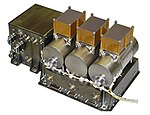
|
Maps mineral composition within the top millimeter of the surface on Mercury by detecting X-ray spectral lines from magnesium, aluminum, sulphur, calcium, titanium, and iron, in the 1-10 keV range.[25][26]
| |||||||||||||||||||||||||||||||||||||||||||||
| Magnetometer (MAG) | ||||||||||||||||||||||||||||||||||||||||||||||

|
Measures the magnetic field around Mercury in detail to determine the strength and average position of the field.[27][28]
| |||||||||||||||||||||||||||||||||||||||||||||
| Mercury Laser Altimeter (MLA) | ||||||||||||||||||||||||||||||||||||||||||||||
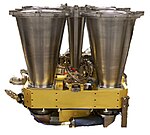
|
Provides detailed information regarding the height of landforms on the surface of Mercury by detecting the light of an infrared laser as the light bounces off the surface. [29][30]
| |||||||||||||||||||||||||||||||||||||||||||||
| Mercury Atmospheric and Surface Composition Spectrometer (MASCS) | ||||||||||||||||||||||||||||||||||||||||||||||
Determines the characteristics of the tenuous atmosphere surrounding Mercury by measuring ultraviolet light emissions and the prevalence of iron and titanium minerals on the surface by measuring the reflectance of infrared light.[31][32]
| ||||||||||||||||||||||||||||||||||||||||||||||
| Energetic Particle and Plasma Spectrometer (EPPS) | ||||||||||||||||||||||||||||||||||||||||||||||
Measures the charged particles in the magnetosphere around Mercury using an Energetic Particle Spectrometer (EPS) and the charged particles that come from the surface using a Fast Imaging Plasma Spectrometer (FIPS).[33][34]
| ||||||||||||||||||||||||||||||||||||||||||||||
| Radio Science (RS) | ||||||||||||||||||||||||||||||||||||||||||||||
Measures the gravity of Mercury and the state of the planetary core by utilizing the spacecraft positioning data.[30][35]
| ||||||||||||||||||||||||||||||||||||||||||||||
Mission profile
| Timeline of observations[2][36][37][38][39][40] | ||||||||||||||||||||||||||||||||||||||||||||||||||||||||||||||||||||||||||||||||||||||||||||||||||||||||||||||||||||||||||
|---|---|---|---|---|---|---|---|---|---|---|---|---|---|---|---|---|---|---|---|---|---|---|---|---|---|---|---|---|---|---|---|---|---|---|---|---|---|---|---|---|---|---|---|---|---|---|---|---|---|---|---|---|---|---|---|---|---|---|---|---|---|---|---|---|---|---|---|---|---|---|---|---|---|---|---|---|---|---|---|---|---|---|---|---|---|---|---|---|---|---|---|---|---|---|---|---|---|---|---|---|---|---|---|---|---|---|---|---|---|---|---|---|---|---|---|---|---|---|---|---|---|---|
| ||||||||||||||||||||||||||||||||||||||||||||||||||||||||||||||||||||||||||||||||||||||||||||||||||||||||||||||||||||||||||
Launch and trajectory
The MESSENGER probe was launched on August 3, 2004 at 06:15:56 UTC by NASA from Space Launch Complex 17B at the Cape Canaveral Air Force Station in Florida, aboard a Delta II 7925 launch vehicle. The complete burn sequence lasted 57 minutes bringing the spacecraft into a heliocentric orbit, with a final velocity of 10.68 km/s (6.64 miles/s) and sending the probe into a 7.9 billion-kilometer trajectory that took 6 years, 7 months and 16 days before its orbital insertion on March 18, 2011.[16]
Traveling to Mercury requires an extremely large velocity change (see delta-v) because Mercury's orbit is deep in the Sun's gravity well. On a direct course from Earth to Mercury, a spacecraft is constantly accelerated as it falls toward the Sun, and will arrive at Mercury with a velocity too high to achieve orbit without excessive use of fuel. For planets with an atmosphere, such as Venus and Mars, spacecraft can minimize their fuel consumption upon arrival by using friction with the atmosphere to enter orbit (aerocapture), or can briefly fire their rocket engines to enter into orbit followed by a reduction of the orbit by aerobraking. However, the tenuous atmosphere of Mercury is far too thin for these maneuvers. Instead, MESSENGER extensively used gravity assist maneuvers at Earth, Venus, and Mercury to reduce the speed relative to Mercury, then used its large rocket engine to enter into an elliptical orbit around the planet. The multi-flyby process greatly reduced the amount of propellant necessary to slow the spacecraft, but at the cost of prolonging the trip by many years and to a total distance of 4.9 billion miles. To further minimize the amount of necessary propellant, the spacecraft orbital insertion targeted a highly elliptical orbit around Mercury.
The elongated orbit has two other benefits: It allows the spacecraft time to cool after the times it is sandwiched between the hot surface and the sun, and it allows the spacecraft to measure the effects of solar wind and the magnetic fields of the planet at various distances, while still allowing close-up measurements and photographs of the surface and exosphere.
Earth flyby
MESSENGER performed a successful Earth flyby a year after launch, on August 2, 2005, with the closest approach at 19:13 UTC at an altitude of 2,347 kilometers (1,458 statute miles) over central Mongolia. On December 12, 2005, a 524 second-long burn (Deep-Space Maneuver or DSM-1) of the large thruster adjusted the trajectory for the upcoming Venus flyby.[41]
During the Earth flyby, the MESSENGER team imaged the Earth and Moon using MDIS and checked the status of several other instruments observing the atmospheric and surface compositions and testing the magnetosphere and determining that all instruments tested were working as expected. This calibration period was intended to ensure accurate interpretation of data when the spacecraft entered orbit around Mercury.[42]
-
A view of Earth from MESSENGER during its Earth flyby.
-
A view of Earth from MESSENGER during its Earth flyby.
-
Earth flyby sequence captured on August 3, 2005. Full-size video available here.
Venus flyby
On October 24, 2006 at 08:34 UTC, MESSENGER encountered Venus at an altitude of 2,992 kilometers (1,859 mi). During the encounter, MESSENGER passed behind Venus and entered superior conjunction, a period when Earth was on the exact opposite side of the Solar System, with the Sun inhibiting radio contact. For this reason, no scientific observations were conducted during the flyby. Communication with the spacecraft was reestablished in late November and performed a deep space maneuver on December 12, to correct the trajectory to encounter Venus in a second flyby.[43]
On June 5, 2007, at 23:08 UTC, MESSENGER performed a second flyby of Venus at an altitude of 338 km (210 mi), for the greatest velocity reduction of the mission. During the encounter, all instruments were used to observe Venus and prepare for the following Mercury encounters. The encounter provided visible and near-infrared imaging data of the upper atmosphere of Venus. Ultraviolet and X-ray spectrometry of the upper atmosphere were also recorded, to characterize the composition. The ESA's Venus Express was also orbiting during the encounter, providing the first opportunity for simultaneous measurement of particle-and-field characteristics of the planet.[44]
Mercury flyby
MESSENGER made a flyby of Mercury on January 14, 2008 (closest approach 200 km above surface of Mercury at 19:04:39 UTC), followed by a second flyby on October 6, 2008.[5] MESSENGER executed a final flyby on September 29, 2009, that further slowed down the spacecraft.[6][7] Sometime during the closest approach of the last flyby, the spacecraft entered safe mode. Although this had no effect on the trajectory necessary for later orbit insertion, it resulted in the loss of science data and images that were planned for the outbound leg of the fly-by. The spacecraft had fully recovered by about seven hours later.[45] One last deep space maneuver, DSM-5 was executed on November 24, 2009 at 22:45 UTC to provide the required velocity change for the scheduled Mercury orbit insertion on March 18, 2011, marking the beginning of a year-long orbital mission.[46]
Initial discoveries
On July 3, 2008, MESSENGER team member Thomas Zurbuchen announced that the probe had discovered large amounts of water present in Mercury's exosphere, which was an unexpected finding.[47] MESSENGER also provided visual evidence of past volcanic activity on the surface of Mercury, as well as evidence for a liquid planetary core.[47]
-
The first high-resolution color Wide Angle Camera image of Mercury acquired by MESSENGER.
-
Smooth plains on Mercury imaged by MESSENGER during the third flyby of the planet.
-
An image of part of the previously unseen side of the planet.
-
Lava-flooded craters and large expanses of smooth volcanic plains on Mercury.
Orbital insertion
The thruster maneuver to insert the craft into Mercury's orbit began at 00:45 AM (UTC) on March 18, 2011. The maneuver lasted about 15 minutes, with confirmation that the craft was in Mercury orbit received at 1:10 AM (UTC) on March 18 (9:10 PM, March 17 EDT).[40] Mission lead engineer Eric Finnegan indicated that the spacecraft had achieved a near-perfect orbit.[48]
MESSENGER's orbit is highly elliptical, taking it within 200 kilometers (120 mi) of Mercury's surface and then 15,000 km (9,300 mi) away from it every twelve hours. This orbit was chosen to shield the probe from the heat radiated by Mercury's hot surface. Only a small portion of each orbit is at a low altitude, where the spacecraft is subjected to heating from the hot side of the planet.[49]
-
Charles Bolden and colleagues wait for news from the MESSENGER probe.
-
Charles Bolden congratulates Eric Finnegan following the successful orbital insertion.
-
The first-ever photograph from Mercury orbit, taken by MESSENGER on March 29, 2011.
-
A simplified chart showing the path of MESSENGER's orbital insertion.
Primary science
After MESSENGER's orbital insertion, an eighteen-day commissioning phase took place. The supervising personnel switched on and tested the craft's science instruments to ensure they had completed the journey without damage.[50] The commissioning phase "demonstrated that the spacecraft and payload [were] all operating nominally, notwithstanding Mercury’s challenging environment.”[19]
The primary mission began as planned April 4, with MESSENGER orbiting Mercury once every twelve hours for an intended duration of twelve Earth months, the equivalent of two solar days on Mercury.[19] Principal Investigator Sean Solomon, then of the Carnegie Institution of Washington, said: “With the beginning today of the primary science phase of the mission, we will be making nearly continuous observations that will allow us to gain the first global perspective on the innermost planet. Moreover, as solar activity steadily increases, we will have a front-row seat on the most dynamic magnetosphere–atmosphere system in the Solar System.”[19]
On October 5, 2011, the scientific results obtained by MESSENGER during its first six terrestrial months in Mercury's orbit were presented in a series of papers at the European Planetary Science Congress in Nantes, France.[9] Among the discoveries presented were the unexpectedly high concentrations of magnesium and calcium found on Mercury's nightside, and the fact that Mercury's magnetic field is offset far to the north of the planet's center.[9]
-
A monochrome image of Mercury from MESSENGER.
-
"Crater-X", named for the raised cross through its centre.
-
A south polar projection of Mercury.
-
A close snapshot of ridges near Mercury's south pole.
Extended mission
In November 2011, NASA announced that the MESSENGER mission would be extended by one year, allowing the spacecraft to observe the 2012 solar maximum.[1] Its extended mission began on March 17, 2012, and continued until March 17, 2013. Between April 16 and April 20, 2012, MESSENGER carried out a series of thruster manoeuvres, placing it in an eight-hour orbit to conduct further scans of Mercury.[51]
In November 2012, NASA reported that MESSENGER had discovered both water ice and organic compounds in permanently shadowed craters in Mercury's north pole.[10][52] In February 2013, NASA published the most detailed and accurate 3D map of Mercury to date, assembled from thousands of images taken by MESSENGER.[53][54] MESSENGER completed its extended mission on March 17, 2013, and is now awaiting approval for a second mission extension.[2]
Solar System portrait

On February 18, 2011, a portrait of the Solar System was published on the MESSENGER website. The mosaic contained 34 images, acquired by the MDIS instrument during November 2010. All the planets were visible with the exception of Uranus and Neptune, due to their vast distances from the Sun. The MESSENGER "family portrait" was intended to be complementary to the Voyager family portrait, which was acquired from the outer Solar System by Voyager 1 on February 14, 1990.[55]
See also
- BepiColombo, a planned European-Japanese Mercury mission
- List of active Solar System probes
- Mariner program
- Stamatios Krimigis, a NASA physicist and key contributor to the mission
References
- ^ a b "NASA extends spacecraft's Mercury mission". UPI. November 15, 2011. Retrieved December 20, 2012.
- ^ a b c d e "MESSENGER Completes Its First Extended Mission at Mercury". JHU – APL. March 17, 2013. Retrieved July 8, 2013.
- ^ Lee, Jimmy; Galuska, Mike (March 18, 2011). "NASA Chats - MESSENGER Prepares to Orbit Mercury". NASA. Archived from the original on June 7, 2011. Retrieved March 18, 2011.
- ^ "NASA Spacecraft Circling Mercury". New York Times. March 17, 2011. Retrieved July 9, 2013.
- ^ a b "Countdown to MESSENGER's Closest Approach with Mercury" (Press release). Johns Hopkins University. January 14, 2008. Retrieved May 1, 2009.
- ^ a b "Critical Deep-Space Maneuver Targets MESSENGER for Its Second Mercury Encounter" (Press release). Johns Hopkins University. March 19, 2008. Retrieved April 20, 2010.
- ^ a b "Deep-Space Maneuver Positions MESSENGER for Third Mercury Encounter" (Press release). Johns Hopkins University. December 4, 2008. Retrieved April 20, 2010.
- ^ "MESSENGER Provides New Look at Mercury's Landscape, Metallic Core, and Polar Shadows" (Press release). Johns Hopkins University. March 21, 2012. Retrieved March 22, 2012.
- ^ a b c "MESSENGER Team Presents New Mercury Findings at Planetary Conference". Johns Hopkins University Applied Physics Laboratory. October 5, 2011. Retrieved November 23, 2011.
- ^ a b "NASA probe reveals organics, ice on Mercury". Reuters. November 29, 2012. Retrieved November 29, 2012.
- ^ Harmon, J. K.; Slade, M. A.; Vélez, R. A.; Crespo, A.; Dryer, M. J.; Johnson, J. M. (1994). "Radar mapping of Mercury's polar anomalies". Nature. 369 (6477): 213–215. Bibcode:1994Natur.369..213H. doi:10.1038/369213a0. ISSN 0028-0836.
- ^ Malik, Tariq (August 16, 2004). "MESSENGER to test theory of shrinking Mercury". USA Today. Retrieved May 23, 2012.
- ^ McAdams, J. V. (August 10–12, 1998). "1998 Astrodynamics Specialist Conference". Boston, MA: American Institute of Aeronautics and Astronautics/American Astronautical Society: 109–115. AIAA-98-4283.
{{cite journal}}:|contribution=ignored (help);|format=requires|url=(help); Cite journal requires|journal=(help); Unknown parameter|coauthors=ignored (|author=suggested) (help) - ^ "MESSENGER - Mission description". NASA. Retrieved July 8, 2013.
- ^ "Discovery Program: MESSENGER". NASA. Retrieved July 8, 2013.
- ^ a b c d e f g h "MESSENGER NASA's Mission to Mercury Launch Press Kit" (PDF) (Press release). NASA / JHUAPL. August 2004. Archived from the original (PDF) on 2007-08-24. Retrieved 2011-02-19.
- ^ "MESSENGER Completes Primary Mission at Mercury, Settles in for Another Year" (Press release). Johns Hopkins University. March 19, 2012. Retrieved 2012-04-10.
- ^ "The Medium-gain Antenna of the MESSENGER Spacecraft". Microwave Journal. October 1, 2005. Retrieved 2011-03-19.
- ^ a b c d "MESSENGER Kicks Off Yearlong Campaign of Mercury Science". JHU – APL. April 4, 2011. Retrieved November 23, 2011.
- ^ a b Hawkins, S. Edward (August 1, 2007). "The Mercury Dual Imaging System on the MESSENGER spacecraft". Space Science Reviews. 131: 247–338. Bibcode:2007SSRv..131..247H. doi:10.1007/s11214-007-9266-3.
{{cite journal}}: Unknown parameter|coauthors=ignored (|author=suggested) (help) - ^ "Mercury Dual Imaging System (MDIS)". NASA/National Space Science Data Center. Retrieved February 19, 2011.
- ^ Hash, Christopher (2007). "MESSENGER Mercury Dual Imaging System (MDIS) Experimental Data Record (EDR) Software Interface Specification (SIS)" (PDF).
{{cite journal}}: Cite journal requires|journal=(help); Unknown parameter|coauthors=ignored (|author=suggested) (help) - ^ a b c d Goldsten, John O. (November 8, 2007). "The MESSENGER Gamma-Ray and Neutron Spectrometer". Space Science Reviews. 131: 339–391. Bibcode:2007SSRv..131..339G. doi:10.1007/s11214-007-9262-7.
{{cite journal}}: Unknown parameter|coauthors=ignored (|author=suggested) (help) - ^ a b "Gamma-Ray and Neutron Spectrometer (GRNS)". NASA / National Space Science Data Center. Retrieved 2011-02-19.
- ^ a b Schlemm, Charles (2007). "The X-Ray Spectrometer on the MESSENGER Spacecraft". Space Science Reviews. 131 (1): 393–415. Bibcode:2007SSRv..131..393S. doi:10.1007/s11214-007-9248-5.
{{cite journal}}: Unknown parameter|coauthors=ignored (|author=suggested) (help) - ^ "X-ray Spectrometer (XRS)". NASA / National Space Science Data Center. Retrieved 2011-02-19.
- ^ a b Anderson, Brian J. (2007). "The Magnetometer Instrument on MESSENGER". Space Science Reviews. 131 (1): 417–450. Bibcode:2007SSRv..131..417A. doi:10.1007/s11214-007-9246-7.
{{cite journal}}: Unknown parameter|coauthors=ignored (|author=suggested) (help) - ^ "Magnetometer (MAG)". NASA / National Space Science Data Center. Retrieved 2011-02-19.
- ^ a b Cavanaugh, John F. (2007). "The Mercury Laser Altimeter Instrument for the MESSENGER Mission". Space Science Reviews. 131 (1): 451–479. Bibcode:2007SSRv..131..451C. doi:10.1007/s11214-007-9273-4.
{{cite journal}}: Unknown parameter|coauthors=ignored (|author=suggested) (help) - ^ a b "Mercury Laser Altimeter (MLA)". NASA / National Space Science Data Center. Retrieved 2011-02-19. Cite error: The named reference "NSSDC" was defined multiple times with different content (see the help page).
- ^ a b McClintock, William (2007). "The Mercury Atmospheric and Surface Composition Spectrometer for the MESSENGER Mission". Space Science Reviews. 131 (1): 481–521. Bibcode:2007SSRv..131..481M. doi:10.1007/s11214-007-9264-5.
{{cite journal}}: Unknown parameter|coauthors=ignored (|author=suggested) (help) - ^ "Mercury Atmospheric and Surface Composition Spectrometer (MASCS)". NASA / National Space Science Data Center. Retrieved 2011-02-19.
- ^ a b Andrews, G. Bruce (2007). "The Energetic Particle and Plasma Spectrometer Instrument on the MESSENGER Spacecraft". Space Science Reviews. 131 (1): 523–556. Bibcode:2007SSRv..131..523A. doi:10.1007/s11214-007-9272-5.
{{cite journal}}: Unknown parameter|coauthors=ignored (|author=suggested) (help) - ^ "Energetic Particle and Plasma Spectrometer (EPPS)". NASA / National Space Science Data Center. Retrieved 2011-02-19.
- ^ a b Srinivasan, Dipak K. (2007). "The Radio Frequency Subsystem and Radio Science on the MESSENGER Mission". Space Science Reviews. 131 (1): 557–571. Bibcode:2007SSRv..131..557S. doi:10.1007/s11214-007-9270-7.
{{cite journal}}: Unknown parameter|coauthors=ignored (|author=suggested) (help) - ^ "Earth Flyby Timeline". JHU/APL. August 2, 2005. Retrieved January 24, 2011.
- ^ "Mercury Flyby 1" (PDF) (Press release). JHU/APL. January 14, 2008. Retrieved January 24, 2011.
- ^ "Mercury Flyby 2" (PDF) (Press release). JHU/APL. October 6, 2008. Retrieved January 24, 2011.
- ^ "Mercury Flyby 3" (PDF) (Press release). JHU/APL. September 29, 2009. Retrieved January 24, 2011.
- ^ a b "MESSENGER Begins Historic Orbit around Mercury" (Press release). NASA/APL. March 17, 2011. Retrieved 2011-03-18.
- ^ "MESSENGER Engine Burn Puts Spacecraft on Track for Venus" (Press release). Johns Hopkins University. December 12, 2005. Retrieved May 1, 2009.
- ^ "MESSENGER Status Report" (Press release). NASA/APL. August 26, 2005. Retrieved March 17, 2011.
- ^ "MESSENGER Completes Venus Flyby" (Press release). NASA/APL. October 24, 2006. Retrieved 2011-03-17.
- ^ "Critical Deep-Space Maneuver Targets MESSENGER for Its First Mercury Encounter" (Press release). Johns Hopkins University. October 17, 2007. Retrieved 2009-05-01.
- ^ "MESSENGER Gains Critical Gravity Assist for Mercury Orbital Observations". MESSENGER Mission News. September 30, 2009. Retrieved 2009-09-30.
- ^ "Deep-Space Maneuver Positions MESSENGER for Mercury Orbit Insertion" (Press release). Johns Hopkins University. November 24, 2009. Retrieved 2010-04-20.
- ^ a b Lakdawalla, Emily (July 3, 2008). "MESSENGER Scientists 'Astonished' to Find Water in Mercury's Thin Atmosphere". The Planetary Society. Retrieved 2009-05-01.
- ^ Roylance, Frank (March 17, 2011). "Messenger successfully goes into orbit around Mercury". Baltimore Sun. Retrieved 2011-03-18.
- ^ Cowen, Ron (March 17, 2011). "MESSENGER eases into Mercury's orbit". Science News. Retrieved 18 March 2011.
- ^ "MESSENGER Mercury Orbit Insertion" (PDF) (Press release). NASA/APL. March 18, 2011. Retrieved March 17, 2011.
- ^ "Messenger settles into new orbit to probe Mercury". Wired UK. April 24, 2012. Retrieved April 29, 2012.
- ^ "Mercury's water ice at north pole finally proven". BBC. 30 November 2012. Retrieved 30 November 2012.
- ^ "New Nasa Photos Show Off Mercury In Brilliant 3D Map (VIDEO)". Huffington Post. February 16, 2013. Retrieved February 16, 2013.
- ^ "Mercury shows off its colourful side". BBC. February 16, 2013. Retrieved February 16, 2013.
- ^ "A Solar System Family Portrait, from the Inside Out" (Press release). APL. February 18, 2011. Retrieved February 18, 2011.
External links
- JHUAPL homepage – official site at Johns Hopkins University Applied Physics Laboratory
- MESSENGER Mission Page – official information regarding the mission on the nasa.gov website
- MESSENGER Mission Profile by NASA's Solar System Exploration
- Mercury Flyby 1 Visualization Tool and Mercury Flyby 1 Actuals – comparison between simulated views of Mercury to the images actually acquired by MESSENGER during flyby 1
- Mercury Flyby 2 Visualization Tool and Mercury Flyby 2 Actuals – comparison between simulated views of Mercury to the images actually acquired by MESSENGER during flyby 2
- MESSENGER Image Gallery
- NSSDC Master Catalog entry
- Video from MESSENGER as it departs Earth
- Mercury data collected by both Mariner 10 and MESSENGER




